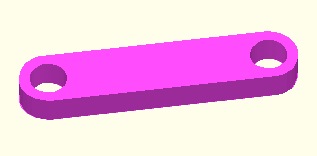VLFLlinkage
by Tim C. Lueth, SG-Lib Toolbox: SolidGeometry 5.6 - Modeling function
Introduced first in SolidGeometry 1.0, Creation date: 2013-04-29, Last change: 2025-09-14
returns a 2½ D solid geometry of a linkage
Description
Tim C. Lueth, Franz Irlinger: "Berechnete Erzeugung von dreidimensionalen Oberflächenmodellen im STL-Format aus der Beschreibung planarer Mechanismen für die Generative Fertigung durch Selektives-Lasersintern [Computational 3D Surface Generation of Planar Mechanismus using STL File Format for Generative Manufacturing by Selective Laser Sintering]", angenommener Beitrag im Konferenzband 10. Kolloquium Getriebetechnik, TU Ilmenau, Sep. 11-13, 2013, pp 1-18.
See Also: VLFLsnapfit
, VLFLshaft
, VLFLhollowsnapaxle
, VLFLcat
, TofDPhiH
, VLtransT
, VLFLspacer
, VLFLbolt
, VLFLwriteSTL
, VLFLofPLELz
, VLFLplot
Example Illustration

Syntax
[VL,FL,PL,EL]=VLFLlinkage(RA,RI,H,D)
Input Parameter
RA: | | Outer Radius |
RI: | | Inner Radius |
H: | | Height |
D: | | Distance in X |
Output Parameter
VL: | | Vertex list |
FL: | | Facet list |
PL: | | Point list of the contour |
EL: | | Contour edge list |
Copyright 2013-2025 Tim C. Lueth. All rights reserved. The code is the property of Tim C. Lueth and may not be redistributed or modified without explicit written permission. This software may be used free of charge for academic research and teaching purposes only. Commercial use, redistribution, modification, or reverse engineering is strictly prohibited. Access to source code is restricted and granted only under specific agreements. For licensing inquiries or commercial use, please contact: Tim C. Lueth
Algorithm (Workflow)
This algorithm generates a 2.5D solid geometry of a linkage based on input parameters. It is designed to create a 3D surface model in STL format for generative manufacturing, specifically for selective laser sintering.
Input Parameters
- RA: Outer Radius
- RI: Inner Radius
- H: Height
- D: Distance in X
Output Results
- VL: Vertex list
- FL: Facet list
- PL: Point list of the contour
- EL: Contour edge list
Algorithm Steps
- Determine the number of facets
n using the function nofrd(RA). Ensure n is even by incrementing if necessary.
- Calculate the angular increment
dw = 2*pi/n and initialize the angle w = pi/2 - dw/2.
- Generate the outer contour points
PLA using a loop from 1 to n, updating the angle w and calculating the coordinates with cos(w)*RA and sin(w)*RA.
- Adjust the x-coordinates of the second half of
PLA by adding D.
- Generate the inner contour points
PLI similarly to PLA, using RI instead of RA.
- Create the edge list
ELA for the outer contour and ELI for the inner contour, reversing the order for ELI.
- Concatenate the point lists
PL and edge lists EL to form the complete contour and edge data.
- Call the function
VLFLofPLELz(PL,EL,H) to generate the vertex list VL and facet list FL, creating the 2.5D solid geometry.
Algorithm explaination created using ChatGPT on 2025-08-19 08:15. (Please note: No guarantee for the correctness of this explanation)
Last html export of this page out of FM database by TL: 2025-09-21